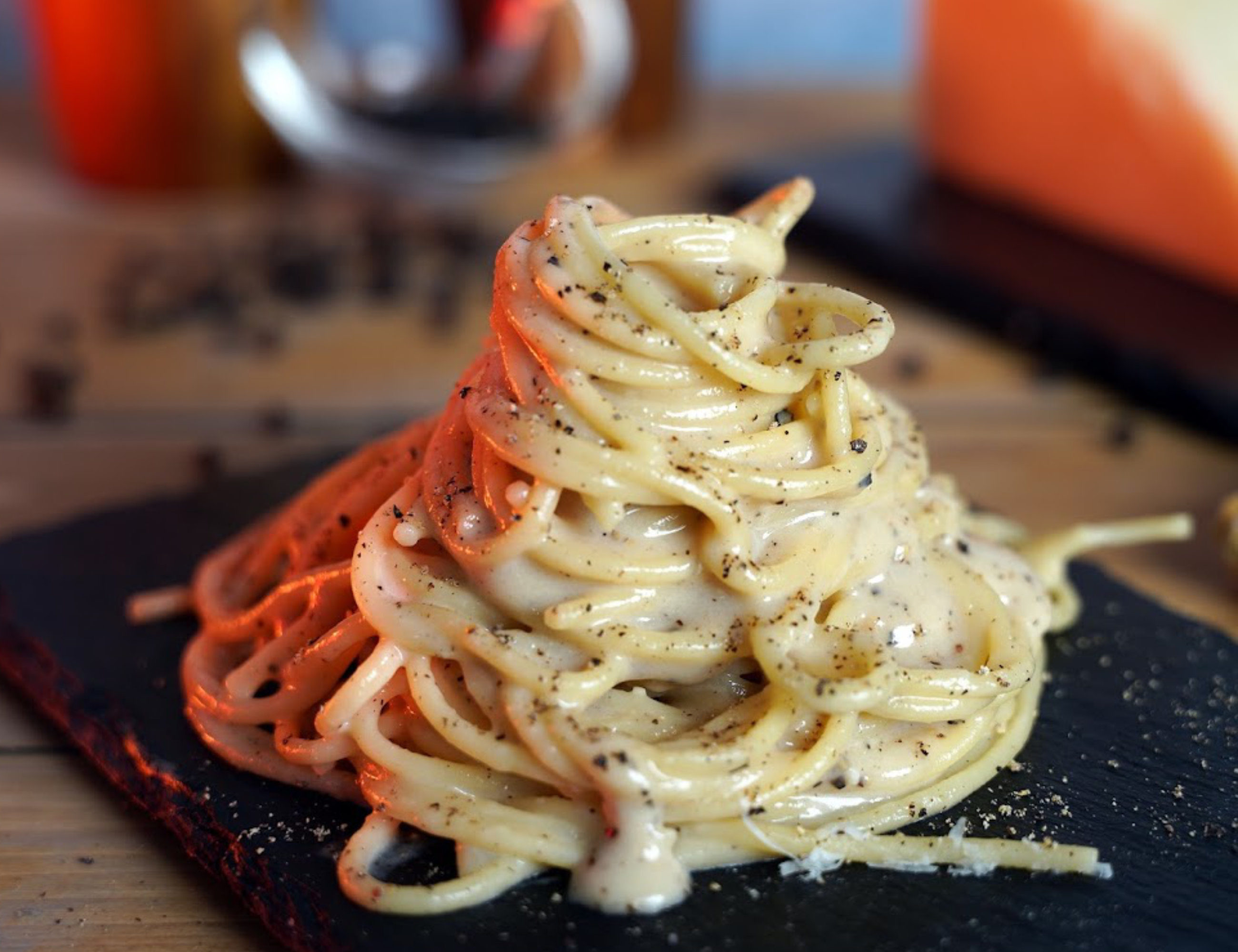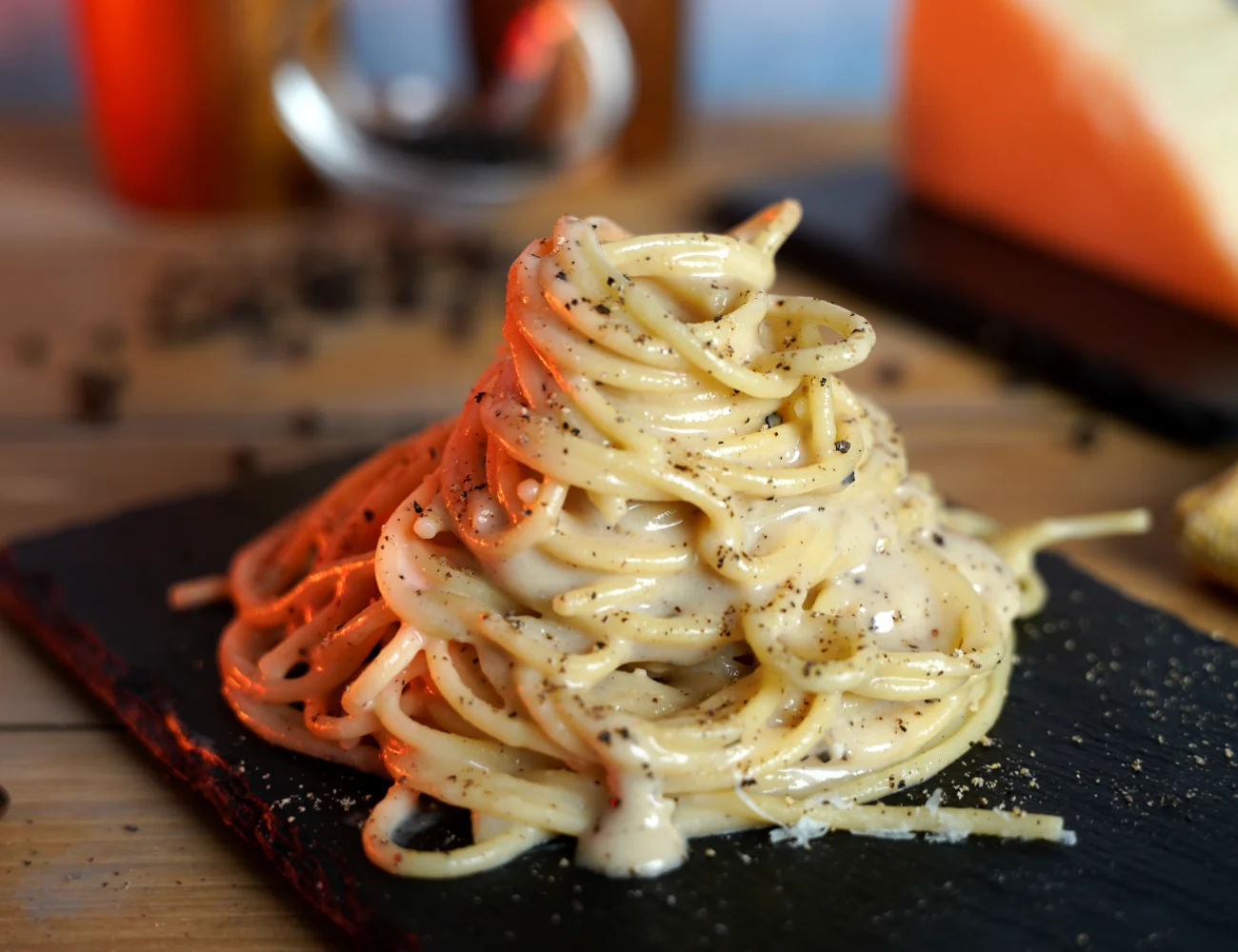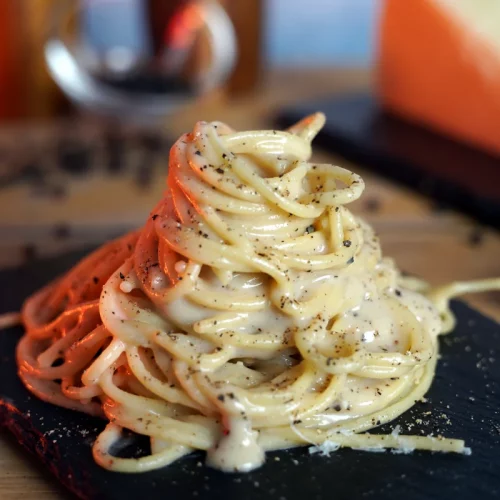Many Pasta Cacio e Pepe video recipes are filmed outside Italy and don’t represent traditional Italian cooking. Not this video! Filmed in Italy with fine Italian ingredients, we show you exactly how to prepare Spaghetti Cacio e Pepe the traditional way—just as it is done in Italy!
What will I learn in this video recipe?
In this PIATTO™ video recipe, we’ll show you how to make the authentic Pasta Cacio e Pepe with spaghetti. This is a classic Roman dish, imitated worldwide by restaurants and Italian food lovers. The authentic Spaghetti Cacio e Pepe recipe is creamy, easy, fast and undeniably delicious.
Video Table of Contents
Want to watch just part of the cooking process? Skip to the part of the video recipe that you want to watch with this Table of Contents:
- 0:00 – intro
- 0:36 – ingredients
- 0:49 – grinding the pepper
- 1:25 – cooking the pasta (first phase)
- 1:38 – how much water to cook the pasta
- 1:48 – how much salt for the water
- 2:06 – toasting the pepper
- 2:34 – more cooking secrets
- 3:04 – cooking the pasta (second phase)
- 3:47 – secrets to making the pecorino sauce
- 4:33 – making the pecorino sauce
- 5:20 – adding the cheese
- 6:00 – the mantecatura
- 6:47 – dish is ready
- 6:57 – plating
- 8:12 – credits
Products We Used in this Video
People often ask us what products we use in our video recipes. From cookware to hard-to-find ingredients, we try whenever possible to share this information with you to help ensure your success in making these traditional Italian food recipes at home!
Heavy Stainless Steel Pan
The specific 3-ply stainless steel pan we used in this video recipe is no longer available. Here’s a similar product of similar quality:
- Lagostina Smart Set of Saucepans in Stainless Steel, 9 Pieces [affiliate link]: https://amzn.to/351PxNz
Salt and Pepper Grinder
Ideally, you grind the pepper fresh when making Cacio e Pepe in order to achieve the best flavor. This Thun pepper grinder was a gift and we love it! Thun is a very popular brand in Italy, for whimsical kitchen items as well as other types of gifts.
- Thun salt / pepper shaker: https://amzn.to/4hQWnHz
Products We Recommend
Spaghetti
In Italian cooking, choosing quality ingredients is everything. Of course, that starts with the pasta! Outside of Italy, pasta quality can vary drastically. There are a few respectable brands (De Cecco, Barilla) that are easily found in groceries that will give you an ok result.
However, in Italy we typically choose brands that we consider superior in both taste and texture. Here are some of our top choices:
- La Molisana Spaghetti Bronzo 15C, 1 Pound (Pack of 18): https://amzn.to/3fmH8M5
- Rummo Italian Pasta Spaghetti (5 Pack,16 Ounce Each): https://amzn.to/3SiECF0
As an Amazon Associate, we earn from qualifying purchases. This means at no extra cost to you, PIATTO may earn a small commission if you click the links and make a qualifying purchase.
Written Spaghetti Cacio e Pepe Recipe?
Yes, we’ve got that too! You can print the recipe card for this Spaghetti Cacio e Pepe recipe below. All recipe cards feature:
- Step-by-step written instructions
- Imperial and metric quantities
- Quantities for 2x or 3x the original recipe—for feeding a crowd!
- Embedded Cacio e Pepe video!
Spaghetti Cacio e Pepe Recipe
Equipment
- Large Pot
- Large Skillet
Ingredients
- 11 oz spaghetti dry is fine
- 1 ½ tbsp black pepper freshly ground at a medium coarse setting
- 7 oz pecorino romano cheese finely grated; use semi-hard if you can find it
- 6 ¾ cups water for cooking the pasta
- coarse salt to taste
Instructions
Prepare Ingredients
- Freshly grate the pecorino with the finest setting available. You may use a food processor to do this quickly. Set aside.7 oz pecorino romano cheese
- Freshly grind the black pepper (1 ½ Tbs) using a medium-coarse setting. You can use a mortar and pestle if you prefer.1 ½ tbsp black pepper
Toast the Black Pepper
- Toast pepper in a large skillet over very low heat just until fragrant. Then, remove pan from the heat. We recommend adding the pepper to a cold skillet, then turning the heat on low. Do not over toast! We don’t want to create pepper gas 🙂
Cook the Pasta
- In a medium-large pot, bring 6 ¾ cups of water to boil. Start cooking the pasta in this pot of water for just half of the cook-time indicated on the package for ‘al dente’ pasta—about 5 minutes.6 ¾ cups water, coarse salt, 11 oz spaghetti
Simmer the Pepper
- While pasta is cooking, add 2-3 ladles of the pasta water to the pan with the black pepper. Return the pan to the heat, and simmer the black pepper in the water for 2 minutes.
Finish the Pasta
- When the pasta is halfway through the cook time, transfer the pasta to the pan with the pepper-infused water.
- Add another ladle of hot pasta water to the pan—just enough to keep the pasta cooking. Finish cooking the pasta until it is al dente. In the meantime…
Make the Pecorino Sauce
- In a bowl, add ½ cup (100 ml) of the hot pasta water to a cup or bowl. Let the water cool a minute or two, or until it has reached a temperature of about 140° F (60° C). Don't have a thermometer? See Notes…
- Add this pasta water to the pecorino cheese.
- Mix thoroughly until you’ve achieved a smooth, thick paste— similar in appearance to a smooth ricotta cheese.
Add the Cheese Sauce
- Remove the skillet with the cooked pasta from the heat. Drain any excess water so only a tablespoon or two of liquid remains in the pan. Add the pecorino paste to the pasta.
- Stir quickly with a pair of tongs until the paste is distributed throughout the pasta and has created a thick, creamy sauce (much like a bechamel). If the pasta seems a bit too watery, remember it will become denser after plating. Serve immediately and Buon appetito!
Video
Nutrition

🇬🇧 This is the English-language version of our original Italian recipe on PIATTO Ricette.

